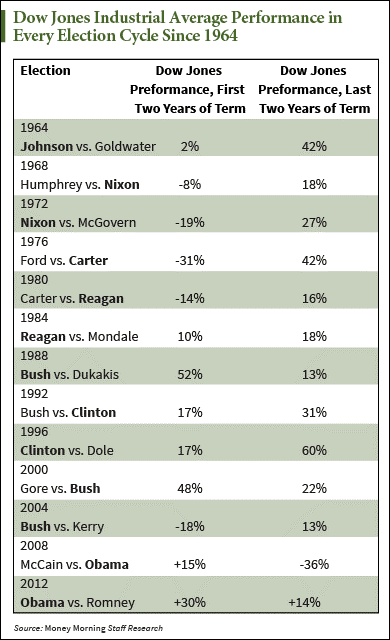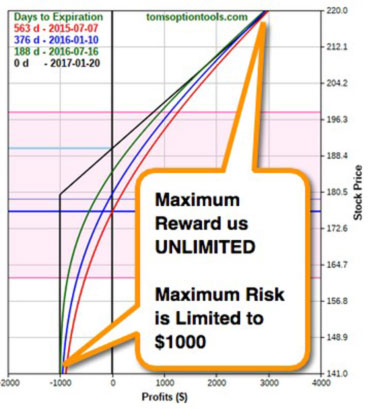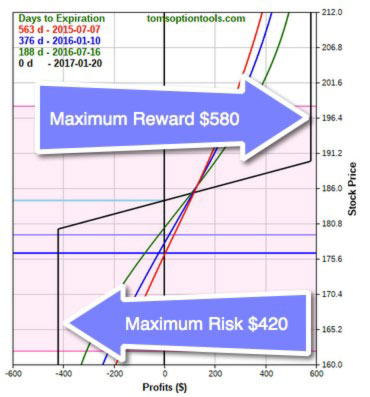Making short-term profits on reliable, long-term patterns is one of the smartest, most profitable moves a trader can make. We make plenty of money with these quick moves - and we can also use these patterns to establish a really lucrative trading strategy.
That's what I have for you today - an opportunity to set a profitable trading plan for 2016.
It's based on a market pattern I first showed you in August - and it's paid off in 74 of the past 75 years. It's called the "presidential pattern" and it's in full swing right now...
Get the Most Out of These Repeating Patterns
The human mind is wonderful at spotting repeating patterns. But it's important - really important - not to get fooled and to use hard data to back up and help establish what you believe to be a pattern. In the case of trading, there's a lot of money at stake - all the more reason to be very sure of what it is you're looking at.
In this case, we can look at simple stock market returns. And the returns tell me that the broad markets are weaker during the first two years of a presidential term and stronger during the last two years of the term.
I believe that there are a variety of reasons for this, but I'm certain it has little or nothing to do with party politics...
A new incoming administration tends to shake things up, to paint in bold strokes, and any new agenda can make waves in the news. The markets simply don't like uncertainty and change, and they respond accordingly.
On the other hand, during the end of a presidential term, a lot of lofty campaign promises start flying around, new public programs are announced, and the party in power takes steps to stimulate the economy in hopes that the public will remember that and stick with their "horse." Markets love sunshine and stimulus.
Just have a look at this simple chart. It measures the performance of the Dow Jones Industrial Average in every election cycle since the Johnson administration.
This pattern suggests a very simple, but potentially very profitable, strategy of buying a Dow tracker, like the SPDR Dow Jones Industrial Average ETF (NYSE Arca: DIA), on the first trading day of January in year four of the cycle until the last trading day in December of year four.
With the Dow hovering around 17,500 and the DIA exchange-traded fund (ETF) at 175, it would cost roughly $17,500 to buy 100 shares of this ETF. If we expect a 15% increase over 2016, than we would expect to return 15% to our cost to buy.
That's simple enough, but here's a way to do it for far less money, for far more returns - with far less risk.
Trading Options on the "Presidential Pattern"
[mmpazkzone name="in-story" network="9794" site="307044" id="137008" type="4"]
We want a LEAPS option, as we've got some time before the next election.
To get performance from this pattern, a trade using the near-money (the options strike price should be close to the current price of the underlying DIA shares) January 2017 LEAPS options would be needed.
So an example of a future trade following the set of rules that were given above would look like this:
On Jan. 4, 2016, you would look at the January 2017 near-money index options on the DIA ETF.
Interestingly, volatility is still inexpensive for long-term options right now. Expect to pay a 6% to 7% premium for the near-money options - as long as the index market's move over the 12 months starting in January 2016 is greater than the premium paid, the strategy will once again prove profitable.
Here's what our LEAPS option looks like.
Have a look at the DIA January 2017 180 calls. As you can see, the last prices were $9.40 to $10.65, so this particular option is mid-priced at $10.00 a contract, or about $1,000, plus commissions.
I'm often asked about the best time to sell. Personally, I like exiting at least half of my position for double my entry price, or a 100% profit.
In the example above, that exit point would come if the calls traded at $20. That would represent a $1,000 per contract profit on an entry price of $10.
This risk graph above reflects the example above. This will give you an excellent idea of what the position looks like based on the price movement of DIA.
It's very important - and interesting - to note that if DIA were to drop, the maximum risk on this position is $1,000 per contract, but the reward is unlimited until expiration.
As good as that is, this trade can get even better...
To Play for Minimum Risk and Cost
You can use a classic bull call spread, designed to further limit risk, but at the expense of limiting reward - a little.
This position takes the same underlying DIA shares, but the cost and risk is lowered by selling the higher strike $190 calls against the purchased $180 calls. This example using the mid-prices above costs just $4.20, or $420 per contract spread, plus commissions.
Now this risk graph reflects the lowered cost and risk, as well as the limited reward.
In this example, the most risk that can occur before expiration is the amount paid for the spread, or in this case, $420. The maximum reward on this spread is $580 per spread, making the reward to risk ratio over 150%.
That's even better when you consider all these profits coming from just a 15% to 20% move in the Dow Jones.
Join the conversation! Follow Tom on Twitter and Facebook.
Click here to get all of Tom's Power Profit Trades options trading lessons and strategies each week. There's no charge for Members, and you'll get access to Tom's one-on-one webinar with Jon Najarian, CNBC host and founder of optionsMONSTER.
About the Author
Tom Gentile, options trading specialist for Money Map Press, is widely known as America's No. 1 Pattern Trader thanks to his nearly 30 years of experience spotting lucrative patterns in options trading. Tom has taught over 300,000 traders his option trading secrets in a variety of settings, including seminars and workshops. He's also a bestselling author of eight books and training courses.



